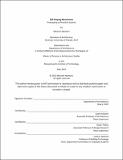| dc.description.abstract | Our surroundings are constantly in flux, whether it is changes in the environment or changes in those who inhabit it. However, most of our spaces and building components are designed for permanence and durability without acknowledging the nuanced fluctuations of the user’s behavior, lifestyle, or changes in the natural environment. The strive for building permanence, designed to resist change, contributes to the 100 million tons of wasted materials annually due to recurring renovations and remodeling that inevitably addresses these fluctuations. What if our parts were active and could sense, react, respond, adapt, and co-evolve with their inhabitants and surrounding context? Rather than building with static dormant components, this alternative presents us with opportunities to advance the built environment and rethink its interrelations with its users and its context, resulting in spaces that are performative and attuned to user needs.
This thesis seeks to develop a typology of lightweight adaptable systems that are rapid and affordable to manufacture. It investigates the fabrication of responsive self-actuating mechanisms; specifically, hybrid pneumatic-knitted (pneu-knit) systems that are autonomous and adaptable to changes within the environment through embedded sensors. The integrated sensors detect the input stimuli–in this particular case study user proximity–transmitting the data to a signal processor and interpreter, which then generates output values for the air pressure settings. This acts as a direct informer and physical shaper of the pneu-knit system, whereby the differentiated shaping generates through the structure and the design of the pneumatic component. The contributions of this work include developing a fabrication framework and method to integrate the knitted, pneumatic, and sensing components for the assembly of affordable, adaptable, lightweight material systems that are attuned to their surroundings. | |
